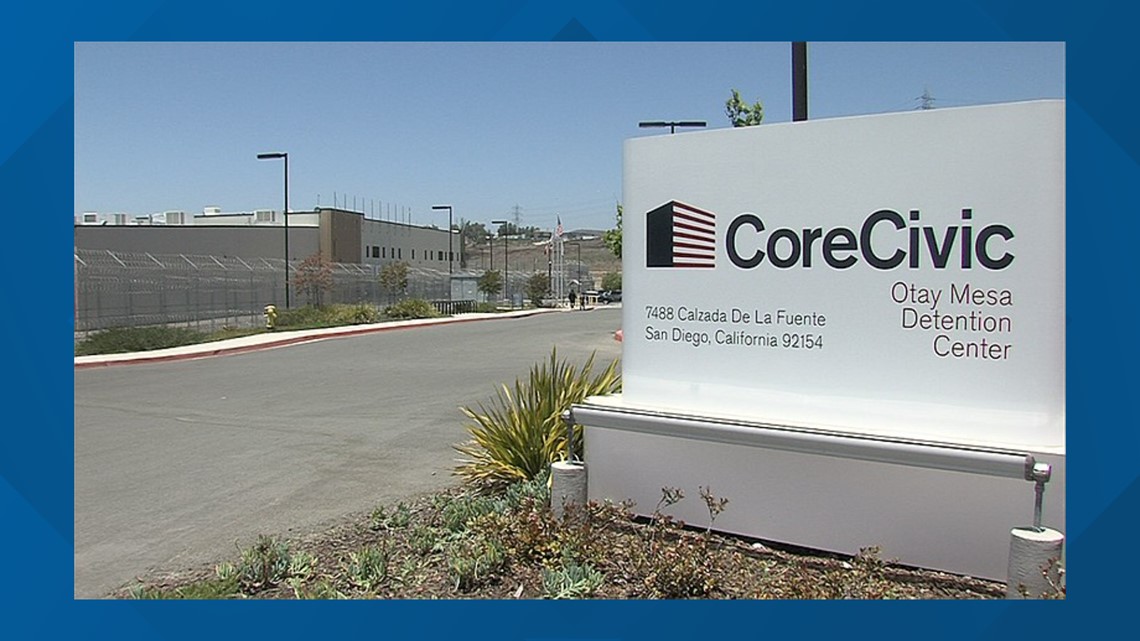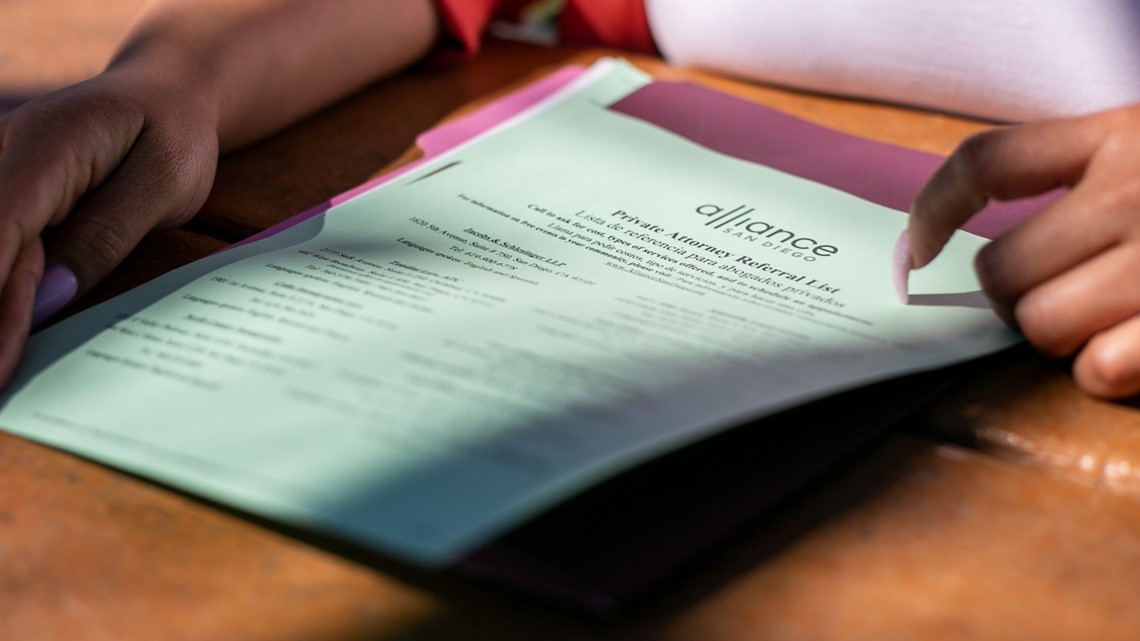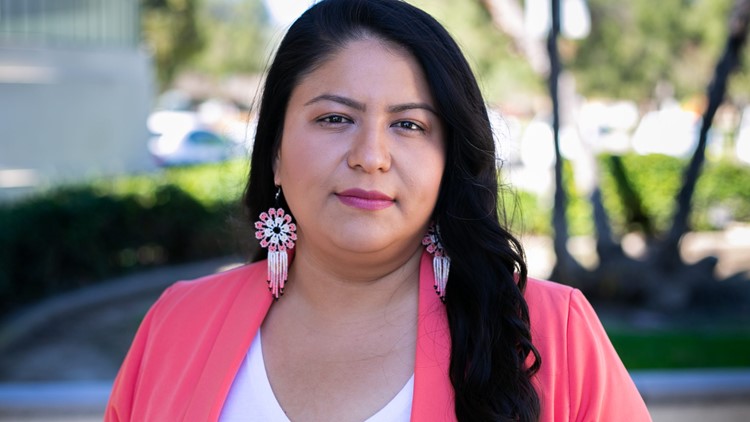SAN DIEGO COUNTY, Calif. — Growing up in a mixed-status family, Lilian Serrano knows the cost of being undocumented well.
“I had the conversation that a lot of children of immigrants have with their parents of what will happen if they ever get caught and deported and what are we gonna do?” Serrano said, who was born in the U.S. but whose parents migrated from Tijuana.
Beyond the emotional and psychological costs of the threat of deportation, the price of legal defense against deportation is costly, too. Serrano said her sister is still paying tens of thousands racked up in attorneys’ fees to fight an ongoing deportation case against her partner.
“I don't think the family has recovered,” said Serrano, community educator and co-director of Universidad Popular, an immigrant-focused community group that holds educational programs in Spanish and English.
A new program approved last year by the San Diego County Board of Supervisors promises to provide no-cost legal representation to migrants in removal proceedings in the county.
The initiative has been hailed as a step toward protecting the rights of those in immigration proceedings, and has been met with gratitude from advocates like Serrano, who said the program will be “life-saving” for the community.
Once the program launches, San Diego will be the first international border county in the nation with such a program, according to the Vera Institute, a criminal justice reform advocacy group that is organizing a nationwide movement to increase access to legal services for those in removal proceedings.
But there could be a major gap in who it serves, advocates said, one that threatens to leave out thousands in need in San Diego County.
Advocates worry that the program could limit services only to detainees held at the immigration detention center in Otay Mesa. That restriction would leave out the growing number of people in alternative detention programs and those who live in the county but have been detained elsewhere.
The scope of the program, budgeted at $5 million for the first pilot year, could hinge on how the county chooses to interpret the wording in the board letter, approved in May, outlining who would be eligible.
A staffer for Supervisor Terra Lawson-Remer, who proposed the program, said exactly who will be eligible for the no-cost legal services is “subject to currently ongoing contract negotiations with the organizations that will help provide legal representation, which we expect County staff to complete in the near future so the public can be updated.”
“Supervisor Lawson-Remer is strongly committed to creating a system that protects the due process rights of all immigrants detained in San Diego County,” Spencer Katz, an adviser for the District 3 supervisor, wrote in an email.
After being projected to launch in December, county officials said the program will be ready to launch in the “near future,” but have not responded to questions from inewsource about when exactly or who will be eligible for the services, citing ongoing contract negotiations.
There are more than 10,000 pending immigration cases in San Diego County. The Otay Mesa Detention Center, the only Immigration and Customs Enforcement, or ICE, facility in the county, has an average daily population of 755, as of mid-January.
Only 17% of federal immigration detainees in San Diego County between 2007 and 2012 were represented by an attorney, according to a 2016 American Immigration Council report.
Advocates see the pilot program as one step toward universal representation, which would mean that any person in removal proceedings would be provided a lawyer by the government. They’re hopeful a future iteration of the program would get them closer to that goal.
“If we can get it there, this program can be a jewel,” said Patricia Mondragon, regional policy manager for Alliance San Diego, a civic engagement organization that provides immigration services.
“Other counties around the nation are showing that type of leadership, and I think we can do it here in San Diego as well.”
Alternatives to detention on the rise
Advocates worry that a growing number of those kept in custody through alternative detention programs could be excluded from the county’s no-cost services, despite still being under immigration authorities’ watch.
More and more, immigration authorities are using alternatives to detention instead of holding migrants in a detention facility while they await their court dates. That change was part of President Joseph Biden’s campaign promise to end prolonged detention for federal immigration detainees.


The national average length of stay in ICE facilities in January was 45 days, compared to 165 the year before, according to data posted online by the agency.
As of mid-January, more than 4,300 people in San Diego County were using alternatives to detention. About 44% are monitored using SmartLink, a smartphone app that uses facial recognition and GPS. Just over a third are monitored with ankle bracelets and the remaining 20% are monitored through voice matching technology over the phone.
A no-cost legal services program that only serves those currently held in detention centers could encourage them to stay in detention where they may have a chance at an attorney, advocates said.
That means they could pass up opportunities to stay in their communities while they wait for their day in court, Mondragon said.
“When people are released on these alternatives to detention and are able to go back home to their families and their communities, they're able to get the support that they need and the resources that they need to prevail in their immigration cases,” Mondragon said.
A detainee’s eligibility for any of the alternatives to the detention are “made on a case by case basis,” said Marcus Johnson, an ICE spokesperson.
ICE officials look at factors such as “criminal, immigration and supervision history; family and/or community ties; status as a caregiver or provider; humanitarian or medical considerations; and the levels of supervision and technology assigned,” Johnson said in an email.
Behind bars across county lines
Advocates have also stressed the need for the program to extend services to migrants who live in San Diego County but have been detained elsewhere, who they fear could be left out as the county finalizes the details of the program’s pilot year.
ICE did not respond to a request for data on how often people are detained outside of their home counties, but Serrano said it’s common for immigration authorities to transfer detainees outside of the county where they were apprehended or between facilities across the country to await their court date.
Those transfers are “based upon operational and mission needs, and [are] completed in accordance with applicable ICE policy,” Johnson said.
“That means that for those of us who live on the edges of the county, there is always going to be that constant, potential situation in which folks are sent to be detained outside of our county, even though they are San Diego residents,” Serrano said.
In addition to her work at Universidad Popular, Serrano works with Alianza Comunitaria, a watchdog network that alerts community members of ICE or Border Patrol checkpoints in the community.


In those roles, she said she’s often a “first responder” to families who have had loved ones detained by immigration agents.
“The impact of a deportation, it's not just on the individual that is being ripped away from his or her community, but also the family,” Serrano said.
Border Patrol has eight stations in and just outside of San Diego County with processing centers for detainees. Where a detainee is taken after being apprehended depends on the availability of bed space and staffing at their next destination, said Tekae Michael, a supervisory Border Patrol agent.
“Everybody's going all over the place. We're just trying to do the best we can and get them out of our custody as soon as possible because we don't have holding facilities,” Michael said.
Border Patrol is not supposed to hold detainees longer than 72 hours before transferring or releasing the migrants.
Meeting migrants’ legal needs
Families and advocates have been calling for no-cost legal services for those facing deportation in the county for years, so the pilot program came as a major win in achieving due process for the immigrant community.
“These cases involve the lives of people, the unity of a family and the welfare of the children who may end up with deported parents,” said Ian Seruelo, an immigration attorney in San Diego and member of the San Diego Immigrant Rights Consortium.
“So the impact of these immigration proceedings are really, really very serious,” Seruelo said.


The data are clear about those who represent themselves in removal proceedings: Only about 5% end up winning their cases, according to a 2015 study from the University of Pennsylvania Law Review.
That’s because the immigration system is designed to work against migrants, said Maria Chavez, an immigration attorney in San Diego who is also a secretary for the local chapter of the American Immigration Lawyers Association.
“They have to try to figure out all of the exceptions and sort of the meandering paths to try to get a win. It's nearly impossible, especially when they don't even speak English in the first place,” Chavez said.
The county opened contract bidding for the program in August, calling for nonprofits to apply to provide the legal services for the program. Jewish Family Service of San Diego, a local nonprofit that provides immigration services, confirmed it applied.
The Southern California Immigration Project and Andrew Nietor, a private practice immigration attorney, submitted a joint bid to the county and are now “in the final stages of contract negotiations,” said Elizabeth Lopez, director and attorney at the pro bono legal service group.
As part of the pilot program, the county Public Defender’s Office, which is coordinating the program, will collect data on the number of people served and the outcome of their cases.
After a year, advocates say they hope the county will evaluate the data and consider ways to come closer to providing universal representation, which the county has signaled in documents is a goal for the permanent program.
But even with greater access to legal services, the impact of the program will be limited by immigration policy at the federal level, Serrano said.
“We expect that even if we create the most perfect program, even if this program were to address the concerns that we had brought forward, we know that we are not going to stop every deportation,” Serrano said. “And we know that the number of deportations in our region will continue.”
inewsource is a nonprofit, independently funded newsroom that produces impactful investigative and accountability journalism in San Diego County. Learn more at inewsource.org.



